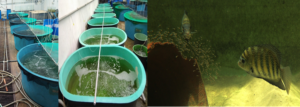Aquaculture is projected to be the prime source of seafood by 2030, as demand grows from the global middle class and wild capture fisheries approach their maximum exploitation. Fish farming can help provide livelihoods and feed a global population by responsible practices. However, for an aquaculture system to be truly sustainable, it must have also satisfy the economic, environmental and social and community sustainability. Sustainable aquaculture is a dynamic concept and the sustainability of an aquaculture system will vary with species, location, societal norms and the state of knowledge and technology.
Growth of aquaculture is absolutely necessary for meeting future demands for food. However, one of the biggest impacts of aquaculture is its environmental impacts. Some aquaculture practices that do not maintain standards and follow sustainable aquaculture practices, negatively impact the environment and also put pressure on wild fish growth by habitat modification and using wild caught fish as fish feed.Aquaculture has also contaminated wild fish habitats with pollution and diseases. Sustainable aquaculture is a real challenge. With the increased demand for seafood and wild caught fish being under constant threat, the world today needs sustainable aquaculture. It can be attained by adopting new technologies and reducing negative environmental impacts. They are Integrated Multi-Trophic Aquaculture (IMTA), and integration of aquaculture with other agriculture allied sectors.Biofloc technologies facilitate intensive culture, while reducing investment and maintenance costs and incorporating the potential to recycle feed. The technology is based upon zero or minimal water exchange to maximize biosecurity while minimizing external environmental effects. Using artificial aeration to meet oxygen demand and suspend organic particles, the development of a heterotrophic microbial community is encouraged in the pond. The main benefit of RAS is the ability to reduce the need for fresh, clean water while still maintaining a healthy environment for fish. To be operated economically commercial RAS must have high fish stocking densities, and many researchers are currently conducting studies to determine if RAS is a viable form of intensive aquaculture. Integrated aquaculture systems (IAS) link aquaculture to conventional farming systems such as poultry farming, horticulture, etc. which is functional in our backyards. In these systems, on-farm wastes and by-products were recycled in relatively closed nutrient cycles.
The development of aquaculture is dependent on knowledge related to various disciplines, and fish nutrition is one of the important aspects among them. The multi-disciplinary nature of aquaculture is strongly expressed in the subject of requirement of quality feed and efficient feed management practices for a profitable venture. Aquaculture is a booming and promising animal protein producing industry for the growing population of the world. Feed is a vital farming input which greatly influences the sustainable aquaculture production. Feed shares the major production cost in aquaculture practice and growing competition for conventional feed ingredient ignite the necessity to search for wide spectrum raw materials, which can be effectively incorporated in the fish feed without any negative impact on the final yield and the environment.Kerala University of Fisheries and Ocean Studies (KUFOS) has Field training facility comprising a total of 54 ponds with a water spread area around of 2 ha in the western campus drawing water from the Vembanad Lake. Ponds are demarcated as Freshwater ponds (FWP 1 to 10) and Brackish Water Ponds (BWP 1 to 44) based on the nature of influx water from Vembanad Lake. Usually, all the brackish water ponds are fresh water in nature during the months from June to October and chances with rise in salinity in the lake and can go up to 22-24 ppt during summer seasons. All the brackish water ponds (44) are tide-fed ponds through the feeder canals lead from the lake and freshwater ponds (10) are rain fed. In addition, there are 10 concrete cement ponds for nursery rearing.
Ten Research Centres are functioning in the School of Aquaculture and Biotechnology of KUFOS, in Plan Project mode, with funding from the 12th Five Year Plan. These Centres were engaged in focused research in all key areas of applied aquaculture over the past four years. The deliverables of these Centres were of much significance, from the research as well as from the farmers’ point of view. Many of the technologies developed have been transferred to the farmers, and has been adopted well by them.The Database developed and the expertise acquired in the varied areas of aquaculture through the aboveResearch Centres, will serve as a solid foundation for more advanced research, aimed at addressing the real issues and ground realities, of the aquaculture sector. Establishment of a Centre of Excellence, for coordinating advanced and continued research, in all these areas, where work has been initiated and proceeded with, in the earlier Plan projects, is now the need of the hour.

THRUST AREAS:
- Developing brood bank for sustainable production of Karimeen Etroplus surantensis (Bloch,1790) employing selective breeding techniques
- Sustainable practices for culture of economically important Non-conventional species freshwater and brackishwater species
- Development of sustainable aquafeed from wide spectrum raw materials and propagation of feed based aquaculture in Kerala
- Bioprospecting of microbes from various aquatic environments for potential application in aquaculture
- Immune gene profiling of aquatic organisms in response to various pathogens and probiotic/immunostimulant application
- Integrated system for multi-disciplinary aquatic animal health research and management
Faculty Associated:
- Dr. Shyama S
- Dr. Devika Pillai
- Dr. Dinesh K
- Dr. Chiranjiv Pradhan
- Dr. Binu Varghese
- Dr. Linoy Libini
- Dr. Rejish Kumar.V.J